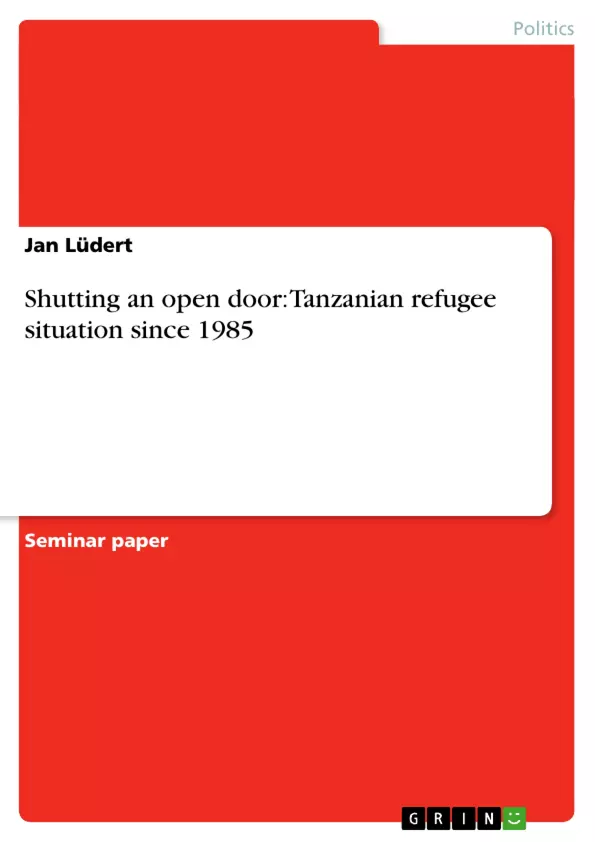The east African country of Tanzania, once praised for its “Open Door Policy” and its committed
support for refugees fleeing turmoil in their respective home countries, has shifted dramatically
within the last two decades. This paper will investigate the changed policy of the Tanzanian
government towards continuous refugee influx after its independence in 1964. It is apparent that
perceptions of refugees have also shifted in local, regional and international arenas and due to the
confines of this paper, developments on these fronts will only be mentioned peripherally.
The refugee situation in the Great Lake Region of Tanzania is of exceptional importance for a
selected number of reasons:
1) Tanzania has been host to the highest number of refugees on the African continent therefore
putting a uncontested burden on the nation
2) The country acts as case for an increasing awareness of sovereignty, especially in terms of
national security in post colonial Africa
3) The historical implications of ethnic separation questions the notion of territoriality in a
region still struggling to create stability
4) Government leadership and ideology influence the perception of refugees and therefore the
formulation of policy
This paper will investigate the above, firstly outlining the refugee arrivals in western Tanzania since
independence; secondly investigating the perception of refugees under the presidency of the Pan
Africanist, Julius Nyerere until 1985; thirdly it will account for refugee policy adjustments
implemented by the government post Nyerereism; and lastly by concluding the above notions
utilising the findings of the preceding paragraphs. Tanzania has been a safe haven for refugees from its western neighbours, namely Burundi, Congo
(former Zaire), Uganda and Rwanda for several decades and the country has continuously hosted
refugees from these countries. Estimates on the number of refugees vary greatly, and no exact
number can be drawn from existing figures post Tanzanian independence, but it is reasonable to
assume refugee volumes of several hundred thousand up to a million from 1959 until 1993. Refugees arriving in the biggest wave between 1993 and 1998 from Rwanda, Burundi and the
Democratic Republic of Congo are thought to have reached close to 1.3 million people.
Inhaltsverzeichnis (Table of Contents)
- Keeping the door ajar or How the perception of Refugees changed in Tanzania following Julius Nyerere's step down in 1985?
- The refugee situation in the Great Lake Region of Tanzania
- Refugee arrivals in western Tanzania since independence
- The perception of refugees under the presidency of Julius Nyerere
- Refugee policy adjustments implemented by the government post Nyerereism
Zielsetzung und Themenschwerpunkte (Objectives and Key Themes)
This paper examines the evolution of Tanzania's refugee policy, specifically exploring the changes in perception towards refugees following the departure of President Julius Nyerere in 1985. The paper investigates the reasons behind this shift and analyzes the impact of economic, political, and social factors on the country's approach to refugee influx.
- The historical context of Tanzania's "Open Door Policy" and its commitment to refugee support.
- The impact of Nyerere's Pan-Africanist ideology and the ujamaa model on refugee integration.
- The shift in government policy and perception towards refugees after Nyerere's departure.
- The role of economic liberalization and structural adjustment programs in influencing the perception of refugees.
- The implications of the shift in policy on the lives of refugees and the host community.
Zusammenfassung der Kapitel (Chapter Summaries)
- The first chapter discusses the historical context of refugee arrival in Tanzania, highlighting the country's role as a significant host for refugees from neighboring countries.
- The second chapter focuses on the perception of refugees during President Nyerere's reign, emphasizing his Pan-Africanist ideology and the implementation of the ujamaa model, which encouraged refugee integration.
- The third chapter explores the changes in refugee policy following Nyerere's departure, outlining the government's shift towards economic liberalization, structural adjustment programs, and a more restrictive approach to refugee influx.
Schlüsselwörter (Keywords)
The key themes and concepts explored in this paper include refugee policy, Tanzania, Julius Nyerere, ujamaa model, economic liberalization, structural adjustment programs, refugee integration, repatriation, and the perception of refugees.
- Quote paper
- Jan Lüdert (Author), 2006, Shutting an open door: Tanzanian refugee situation since 1985, Munich, GRIN Verlag, https://www.grin.com/document/90024



